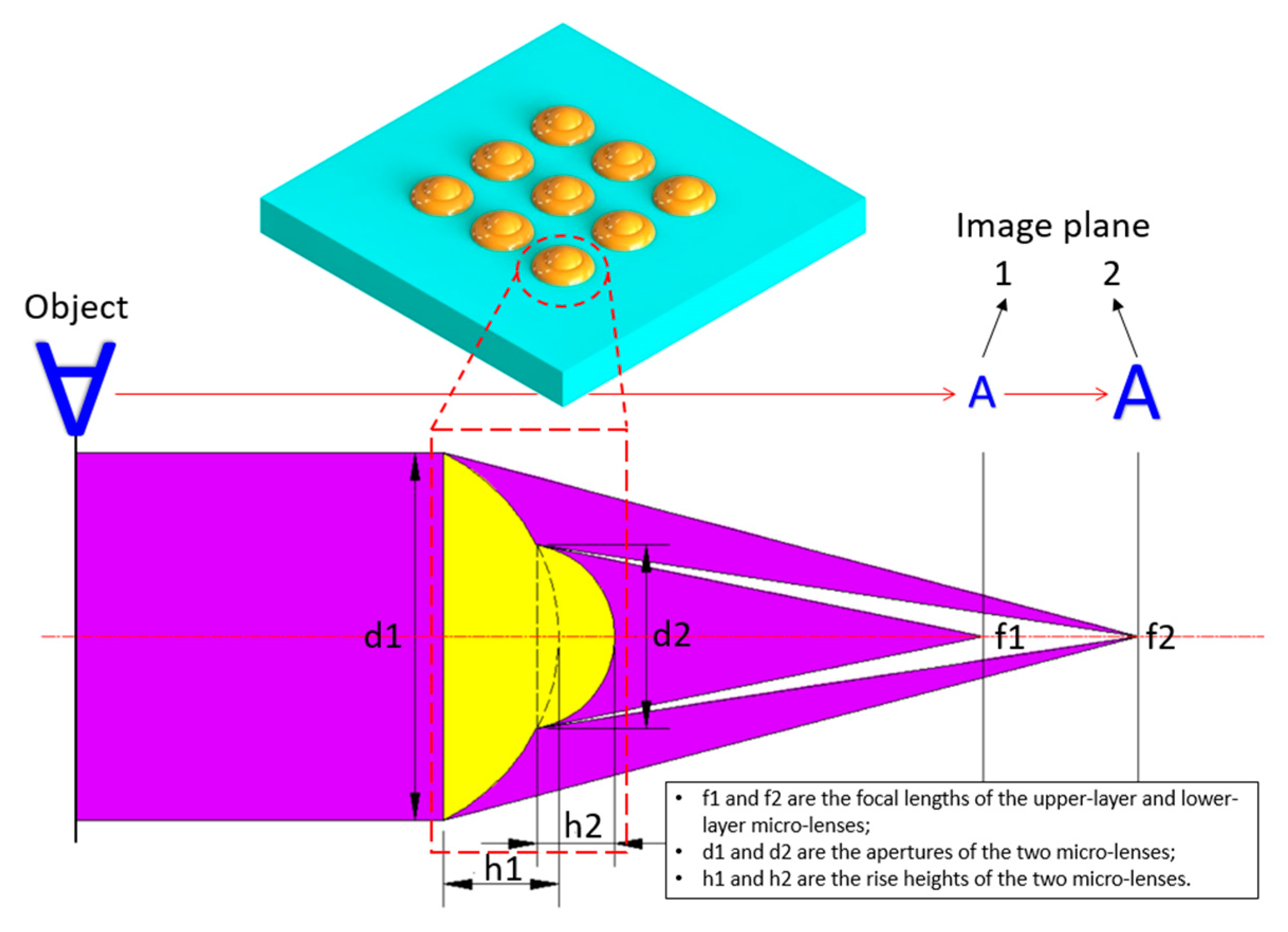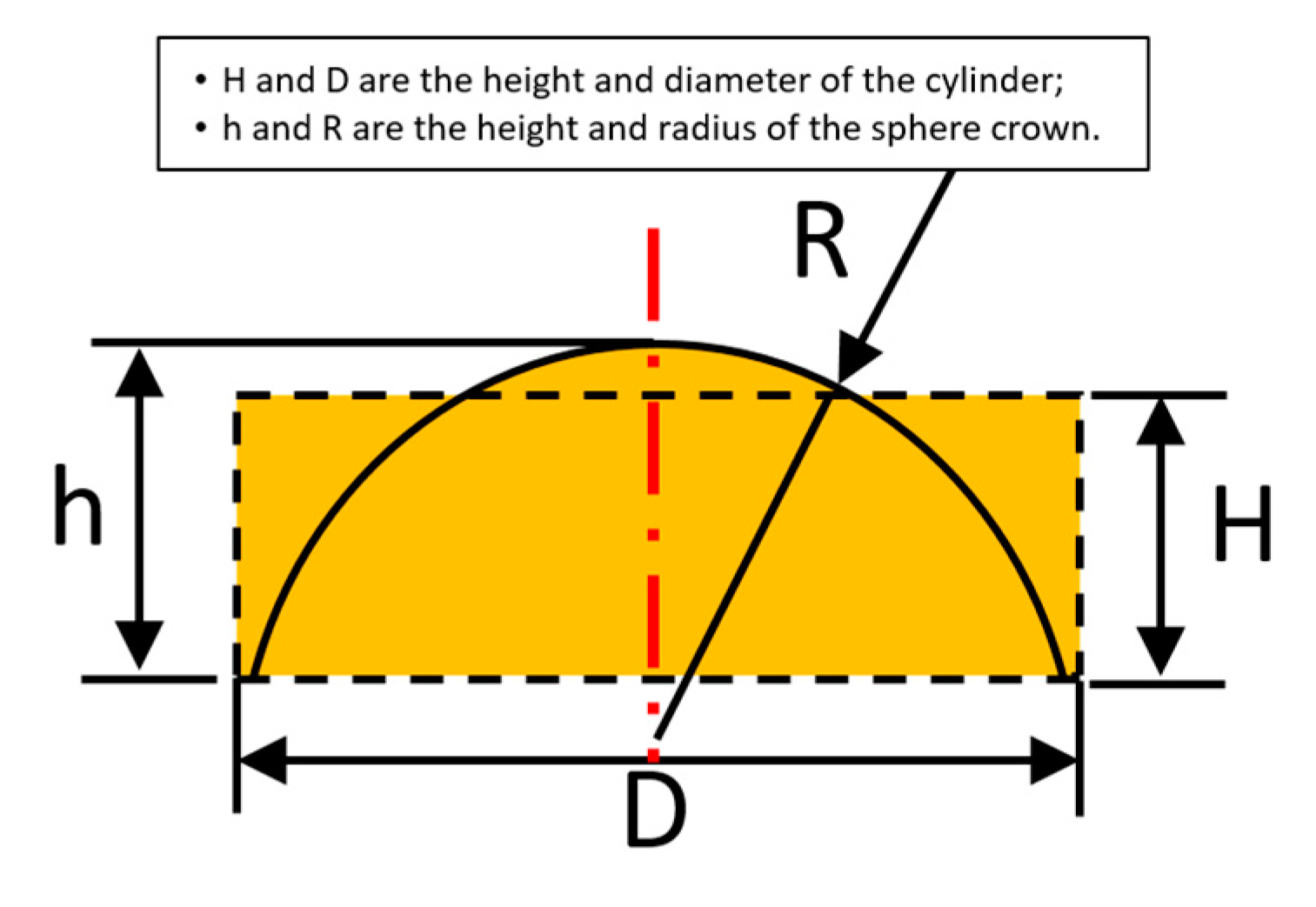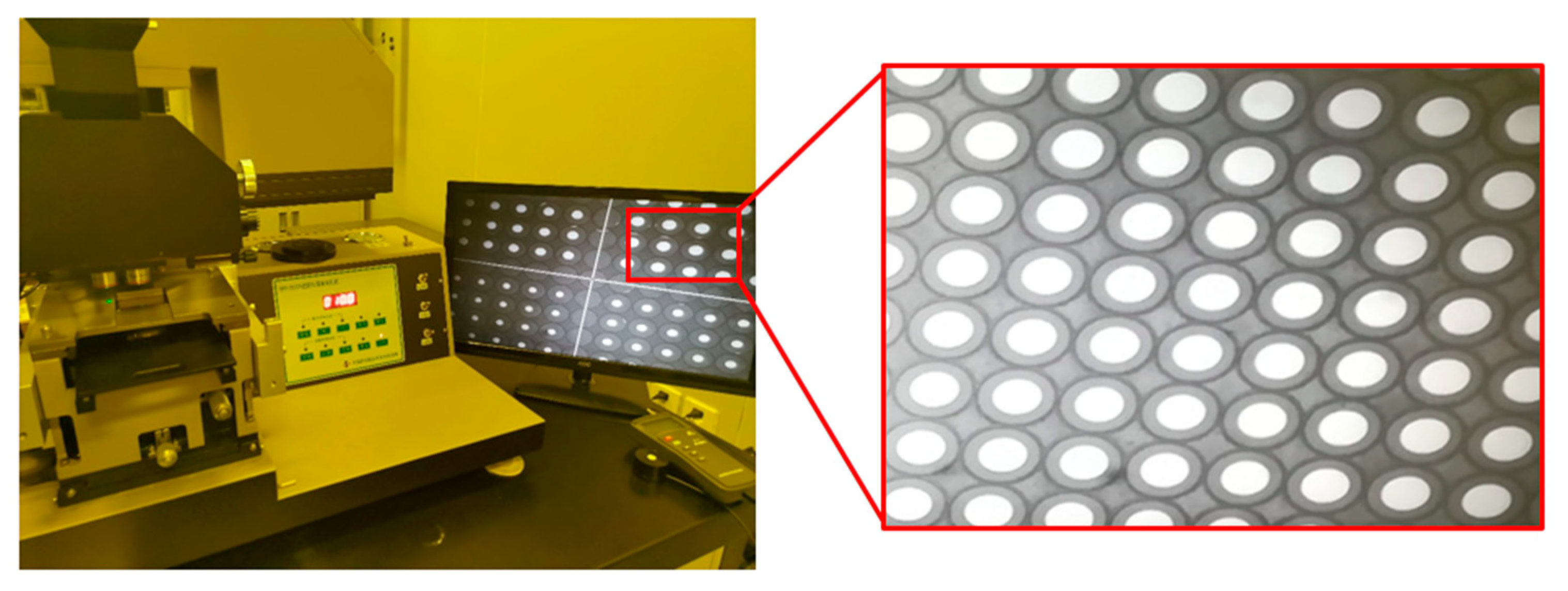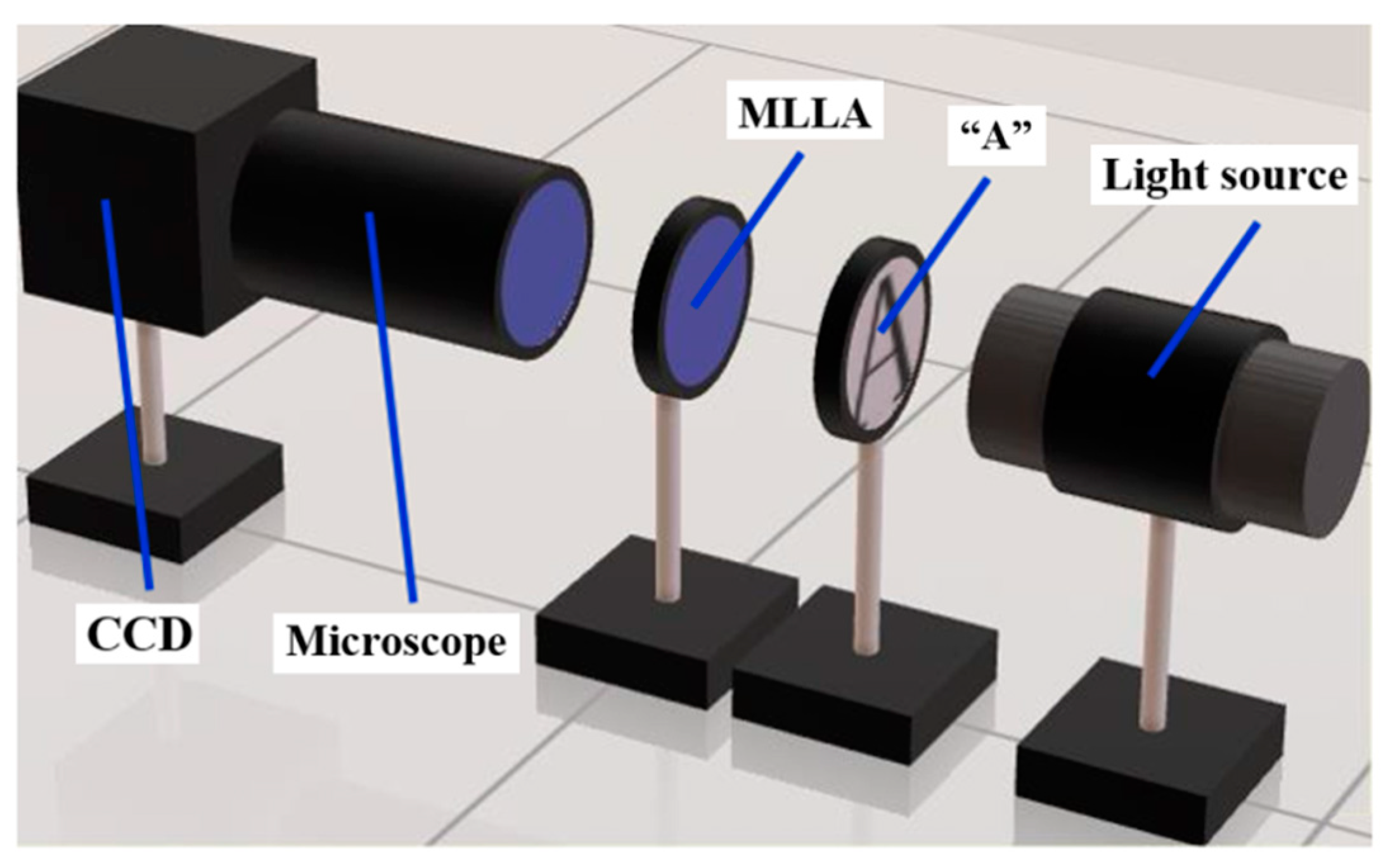A Novel Fabricating Method of Micro Lens-on-Lens Arrays with Two Focal Lengths
Abstract
:1. Introduction
2. Materials and Methods
3. Results and Discussion
4. Conclusions
Author Contributions
Funding
Conflicts of Interest
References
- Lin, V.; Wei, H.-C.; Hsieh, H.-T.; Su, G.-D.J. An optical wavefront sensor based on a double layer microlens array. Sensors 2011, 11, 10293–10307. [Google Scholar] [CrossRef] [Green Version]
- Gokce, S.K.; Holmstrom, S.; Hibert, C.; Olcer, S.; Bowman, D.; Urey, H. Two-dimensional MEMS stage integrated with microlens arrays for laser beam steering. J. Microelectromech. Syst. 2011, 20, 15–17. [Google Scholar] [CrossRef] [Green Version]
- Zhang, H.; Li, L.; McCray, D.L.; Scheiding, S.; Naples, N.J.; Gebhardt, A.; Risse, S.; Eberhardt, R.; Tünnermann, A.; Yi, A.Y. Development of a low cost high precision three layer 3D artificial compound eye. Opt. Express 2013, 21, 22232–22245. [Google Scholar] [CrossRef]
- Elsherif, M.; Moreddu, R.; Hassan, M.U.; Yetisen, A.K.; Butt, H. Real-time optical fiber sensors based on light diffusing microlens arrays. Lab Chip 2019, 12, 2060–2070. [Google Scholar] [CrossRef]
- Georgiev, T.; Yu, Z.; Lumsdaine, A.; Goma, S. Lytro camera technology: Theory, algorithms, performance analysis. Proc. SPIE 2013, 8667, 86671J1-10. [Google Scholar]
- Wu, M.-H.; Park, C.; Whitesides, G.M. Fabrication of arrays of microlenses with controlled profiles using gray-scale microlens projection photolithography. Langmuir 2002, 18, 9312–9318. [Google Scholar] [CrossRef]
- Olivieri, F.; Todino, M.; Coppola, S.; Vespini, V.; Pagliarulo, V.; Grilli, S.; Ferraro, P. Fabrication of polymer lenses and microlens array for lab-on-a-chip devices. Opt. Eng. 2016, 55, 081319-16. [Google Scholar] [CrossRef]
- Koyama, S.; Onozawa, K.; Tanaka, K.; Saito, S.; Kourkouss, S.M.; Kato, Y. Multiocular image sensor with on-chip beam splitter and inner meta-micro-lens for single-main-lens stereo camera. Opt. Express 2016, 24, 18035–18048. [Google Scholar] [CrossRef]
- Algorri, J.F.; Bennis, N.; Urruchi, V.; Morawiak, P.; Sánchez-Pena, J.M.; Jaroszewicz, L.R. Tunable liquid crystal multifocal microlens array. Sci. Rep. 2017, 7, 17318–17323. [Google Scholar] [CrossRef] [Green Version]
- Hsieh, P.-Y.; Chou, P.-Y.; Lin, H.-A.; Chu, C.-Y.; Huang, C.-T.; Chen, C.-H.; Qin, Z.; Corral, M.M.; Javidi, B.; Huang, Y.-P. Long working range light field microscope with fast scanning multifocal liquid crystal microlens array. Opt. Express 2018, 26, 10981–10996. [Google Scholar] [CrossRef]
- Shi, J.; Huang, Y.-S.; Peng, L.-N.; Ni, Z.-J.; Zhang, D.-W. Grating/microlens arrays fabricated by hot-melting, self-assembly and replication. Opt. Mater. 2020, 104, 109733–109742. [Google Scholar] [CrossRef]
- Tan, J.-Y.; Goh, G.; Kim, J. Microfabrication of microlens by timed-development-and-thermal-reflow (TDTR) process for projection lithography. Micromachies 2020, 11, 277. [Google Scholar] [CrossRef] [Green Version]
- Roy, E.; Voisin, B.; Gravel, J.-F.; Peytavi, R.; Boudreau, D.; Veres, T. Microlens array fabrication by enhanced thermal reflow process: Towards efficient collection of fluorescence light from microarrays. Microelectron. Eng. 2009, 86, 2255–2261. [Google Scholar] [CrossRef]
- Kumaresan, Y.; Rammohan, A.; Dwivedi, P.K.; Sharma, A. Large area IR microlens arrays of chalcogenide glass photoresists by grayscale maskless lithography. ACS Appl. Mater. Interfaces 2013, 5, 7094–7100. [Google Scholar] [CrossRef]
- Zhong, K.; Gao, Y.; Li, F.; Zhang, Z.; Luo, N. Fabrication of PDMS microlens array by digital maskless grayscale lithography and replica molding technique. Optik 2014, 125, 2413–2416. [Google Scholar] [CrossRef]
- Yang, J.-J.; Liao, Y.-S.; Chen, C.-F. Fabrication of long hexagonal micro-lens array by applying gray-scale lithography in micro-replication process. Opt. Commun. 2007, 270, 433–440. [Google Scholar] [CrossRef]
- Cantor, A.J.; Hobbs, R.H. Theory of 2-D ion exchange in glass: Optimization of microlens arrays. Appl. Opt. 1991, 30, 2704–2713. [Google Scholar] [CrossRef]
- Chen, J.; Zhang, F.; Chen, X.; Zhao, Z.; Zhou, S.; Jiang, X.; Liu, D. Optical properties of square-aperture planar microlens array. Proc. SPIE 2011, 8191, 1–8. [Google Scholar]
- Yang, Q.; Tong, S.; Chen, F.; Deng, Z.; Bian, H.; Du, G.; Yong, J.; Hou, X. Lens-on-lens microstructures. Opt. Lett. 2015, 40, 5359–5362. [Google Scholar] [CrossRef]
- Cao, A.; Wang, J.; Pang, H.; Zhang, M.; Shi, L.; Deng, Q.; Hu, S. Multifocal microlens for bionic compound eye. Proc. SPIE 2017, 10460, 104600v1-7. [Google Scholar]
- Cao, A.; Wang, J.; Pang, H.; Zhang, M.; Shi, L.; Deng, Q.; Hu, S. Design and fabrication of a multifocal bionic compound eye for imaging. Bioinspiration Biomim. 2018, 13, 026012. [Google Scholar] [CrossRef]










| Microstructure | T (μm) | D (μm) | H (μm) | H (μm) | F (μm) |
|---|---|---|---|---|---|
| 1—upper micro lens arrays | 100 | 40 | 4.5 | 6.9 | 58 |
| 2—lower micro lens arrays | 96 | 4.7 | 6.7 | 344 |
Publisher’s Note: MDPI stays neutral with regard to jurisdictional claims in published maps and institutional affiliations. |
© 2021 by the authors. Licensee MDPI, Basel, Switzerland. This article is an open access article distributed under the terms and conditions of the Creative Commons Attribution (CC BY) license (https://creativecommons.org/licenses/by/4.0/).
Share and Cite
Liu, X.; Li, M.; Bian, J.; Du, J.; Li, B.; Fan, B. A Novel Fabricating Method of Micro Lens-on-Lens Arrays with Two Focal Lengths. Micromachines 2021, 12, 1372. https://doi.org/10.3390/mi12111372
Liu X, Li M, Bian J, Du J, Li B, Fan B. A Novel Fabricating Method of Micro Lens-on-Lens Arrays with Two Focal Lengths. Micromachines. 2021; 12(11):1372. https://doi.org/10.3390/mi12111372
Chicago/Turabian StyleLiu, Xin, Min Li, Jiang Bian, Junfeng Du, Bincheng Li, and Bin Fan. 2021. "A Novel Fabricating Method of Micro Lens-on-Lens Arrays with Two Focal Lengths" Micromachines 12, no. 11: 1372. https://doi.org/10.3390/mi12111372
APA StyleLiu, X., Li, M., Bian, J., Du, J., Li, B., & Fan, B. (2021). A Novel Fabricating Method of Micro Lens-on-Lens Arrays with Two Focal Lengths. Micromachines, 12(11), 1372. https://doi.org/10.3390/mi12111372






